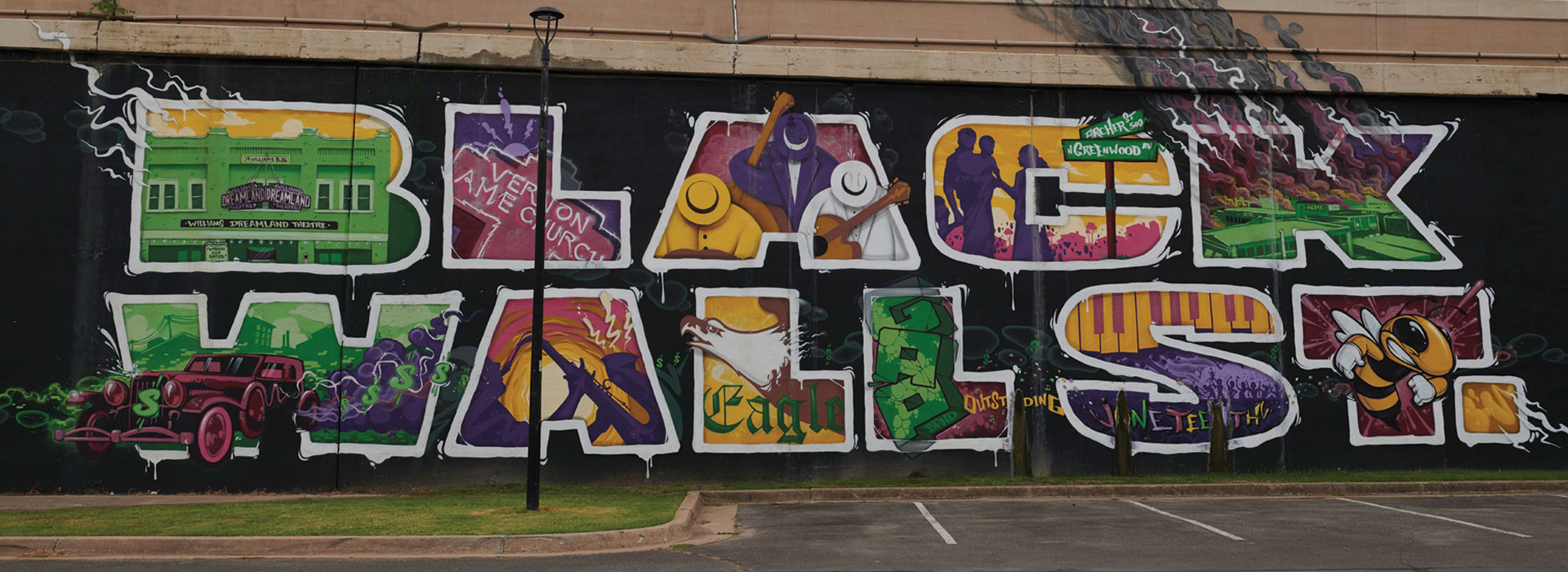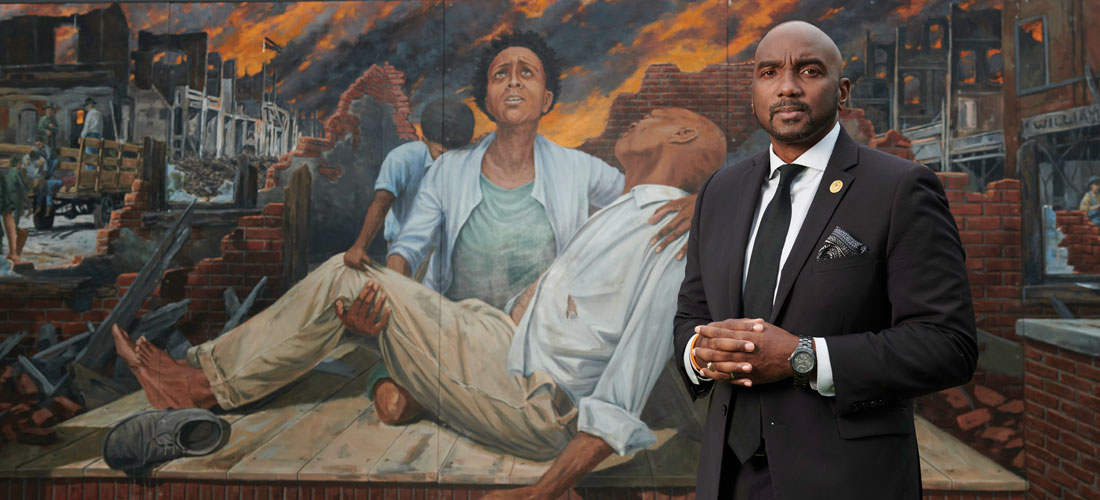
Civil rights attorney Damario Solomon-Simmons has faced his share of setbacks in the fight for justice for survivors of the 1921 Tulsa Race Massacre, one of the worst racial terror attacks in U.S. history.
Nearly two decades ago, the Oklahoma attorney was part of a legal team that lost a lawsuit in federal court for more than 200 survivors of the attack and their descendants after a judge ruled the claims were time-barred.
Solomon-Simmons then advocated for a bill for survivors in Congress. But that effort also failed.
Year after year, the number of known survivors of the attack dwindled. Solomon-Simmons knew he would have to act fast if the remaining living witnesses were going to see justice and have their day in court.
“All around, we were losing survivors. In about 2016 or 2017, I was filled with despair. Every avenue was closed,” he says.
"This is a win that we need as a people." –Damario Solomon-Simmons
But he never gave up hope. It took Solomon-Simmons a few more years to come up with a legal theory to get around the statute of limitations. In September 2020, he filed a public nuisance and unjust enrichment complaint against the city of Tulsa, other governmental entities and the Tulsa Regional Chamber in Tulsa County District Court, seeking reparations for survivor Lessie Benningfield Randle and eight other plaintiffs.
In May, Solomon-Simmons had one of his first victories when Judge Caroline Wall denied in part a motion to dismiss filed by the defendants. But Wall’s written order, filed in August, gave only direct survivors legal standing to make a public nuisance claim, dismissing as plaintiffs descendants who had joined the lawsuit.
Wall gave the only three known living witnesses to the massacre—108-year old Viola Fletcher; Randle, 107; and Hughes Van Ellis, 101—an opportunity to amend their petition to cure what she said were defects in their claim of unjust enrichment and in their claim for reparations.
With the clock ticking, the stakes are high. Solomon-Simmons says the case could be the “last best hope” for the survivors to see some form of justice before they die.
“This massacre impacted Black people around this nation,” Solomon-Simmons says. “This is a win that we need as a people.”

The Tulsa Race Massacre took place May 31 and June 1, 1921, and was sparked by news reports claiming a 19-year-old Black man and shoe shiner named Dick Rowland had assaulted a white woman.
According to some accounts, Rowland was arrested on assault charges after tripping in an elevator in the Drexel Building in Tulsa and grabbing on to the arm of white elevator operator Sarah Page. Unfounded rumors of an attempted rape began to spread among whites in Tulsa, and tensions reached a boiling point.
There was a standoff between Black men—including World War I veterans who offered to help the sheriff protect Rowland, who was detained in jail—and those who wanted to lynch Rowland. A white mob of more than 1,000 had gathered outside the courthouse. A shot was fired. And with that, said a 2001 report by the Oklahoma Commission to Study the Tulsa Race Riot of 1921, “America’s worst race riot had begun.”

The vengeful mob, some armed and deputized by city officials, destroyed 35 square blocks of the prosperous Black district in north Tulsa known as Greenwood, or Black Wall Street. They torched and firebombed dozens of businesses, a school, a public library, churches and more than 1,000 homes. In less than 24 hours, the wealth the community had built vanished into ashes.
Up to 300 people were killed, according to the American Red Cross, and thousands were injured, but historians estimate that number could be greater. About 9,000 people were left homeless and 6,000 were forced into temporary internment camps, many living there well into the winter, where they were exposed to disease and suffered malnutrition. Some Black Greenwood residents were blamed and indicted for inciting a riot.
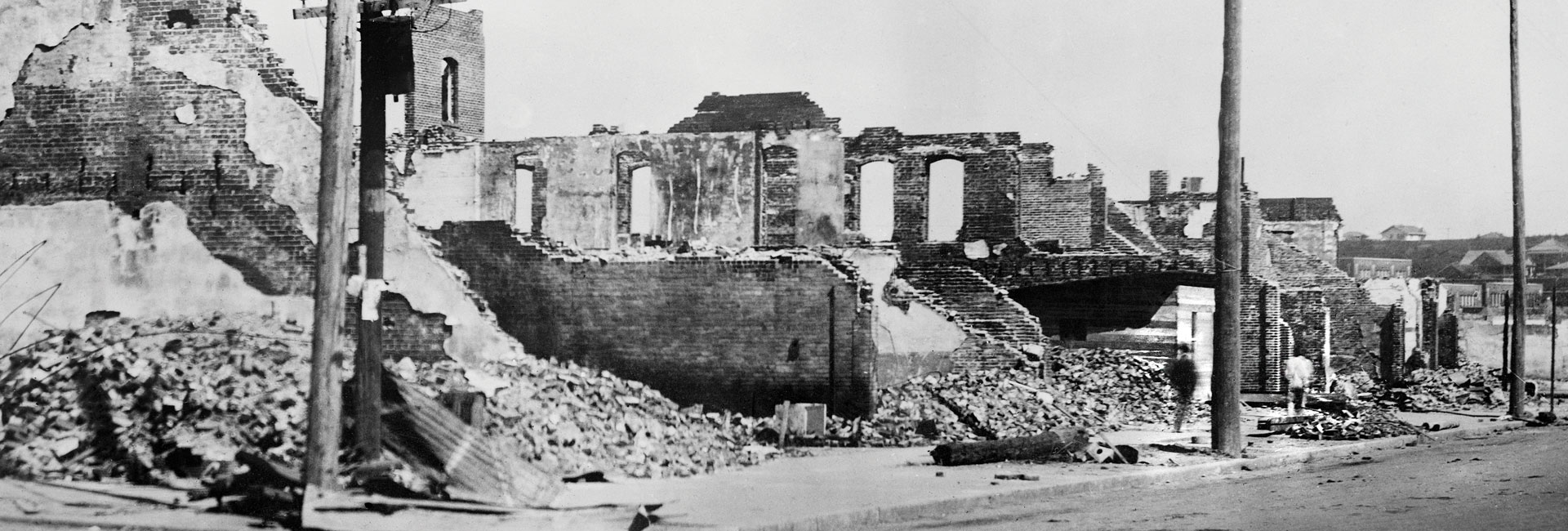
Benningfield, Fletcher and Van Ellis, who were children at the time, saw the mayhem firsthand, Solomon-Simmons says. They smelled the gunpowder and kerosene. They saw the smoke and fire. They heard the screams. They saw the corpses piling up in the streets.
Sara E. Solfanelli, special counsel for pro bono initiatives at Schulte Roth & Zabel, which is co-counsel with Solomon-Simmons, says the Black community in north Tulsa still feels the impact of the attack today. She adds that the mob destroyed the community hospital. It was never rebuilt, and “simple access to health care for the Black community around Greenwood has never come back.”
In her August order, Wall allowed the plaintiffs to go forward with claims that the massacre itself constituted a public nuisance, letting them proceed to the discovery phase. But Wall rejected the allegation that the destruction constituted an “ongoing” public nuisance that over decades resulted in redlining and unjust policing, for example.
In early September, the plaintiffs filed an amended complaint seeking the replacement of buildings, homes and businesses destroyed during the massacre, among other damages and remedies. They also revived a claim of unjust enrichment, alleging the city had exploited “the historic reputation and legacy of the massacre and the ongoing nuisance to their benefit” without benefiting survivors.
In a press conference after the ruling, attorneys for the plaintiffs struck an optimistic tone.
“I just want to think about that we have this victory,” Solomon-Simmons said. “And we have the ability to move forward if the judge allows us to do it, and I know we can prove that this was a nuisance.”
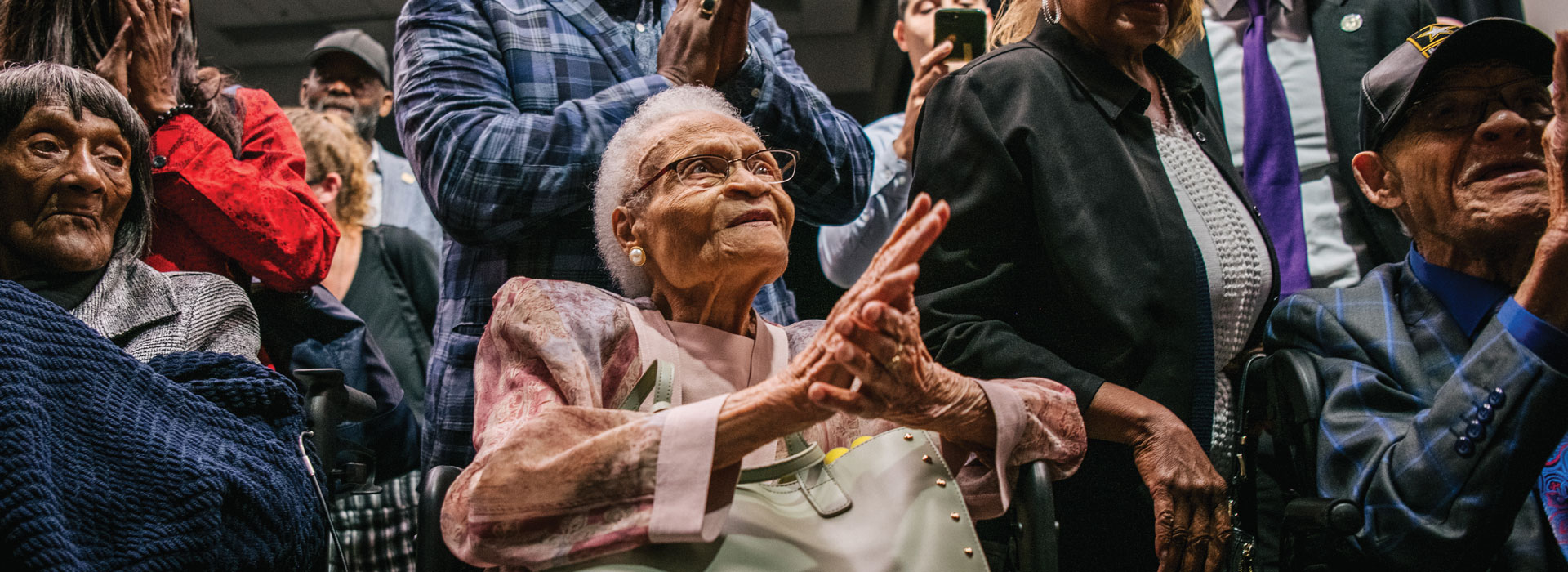
The team praised Wall’s finding that the survivors have legal standing, while expressing disappointment that descendants did not. They said they’re exploring all legal options but want to seize the opportunity to move forward.
“This order is the first time that ... three survivors have managed to move to the merits stage of holding the city, the county, the sheriff and the chamber of commerce accountable for the Tulsa Race Massacre,” says Eric Miller, a professor at Loyola Marymount University’s Loyola Law School in Los Angeles.
“And Uncle Red [Van Ellis] has pledged to live till 130 if it takes that long to win this case,” added Schulte Roth & Zabel attorney Michael Swartz. “So there’s always that.”
Solomon-Simmons was sitting in an introduction to African American studies class taught by a “big, intimidating” University of Oklahoma professor when he first learned about the attack. Solomon-Simmons usually kept his thoughts to himself. But when the professor started describing the massacre, his hand shot up.
“That’s not true,” Solomon-Simmons told the professor. “I’m from Tulsa. I don’t know what you’re talking about.”
Solomon-Simmons was born and raised in Tulsa. He attended Carver Middle School and Booker T. Washington High School in the heart of north Tulsa. He had never heard of the massacre.
It didn’t seem possible he had missed this. Now his professor was telling him it happened right on his doorstep?
“Of course, I was completely wrong,” Solomon-Simmons says with a chuckle. “Once I realized I was wrong, I had a great sense of shame, embarrassment—just disbelief.”
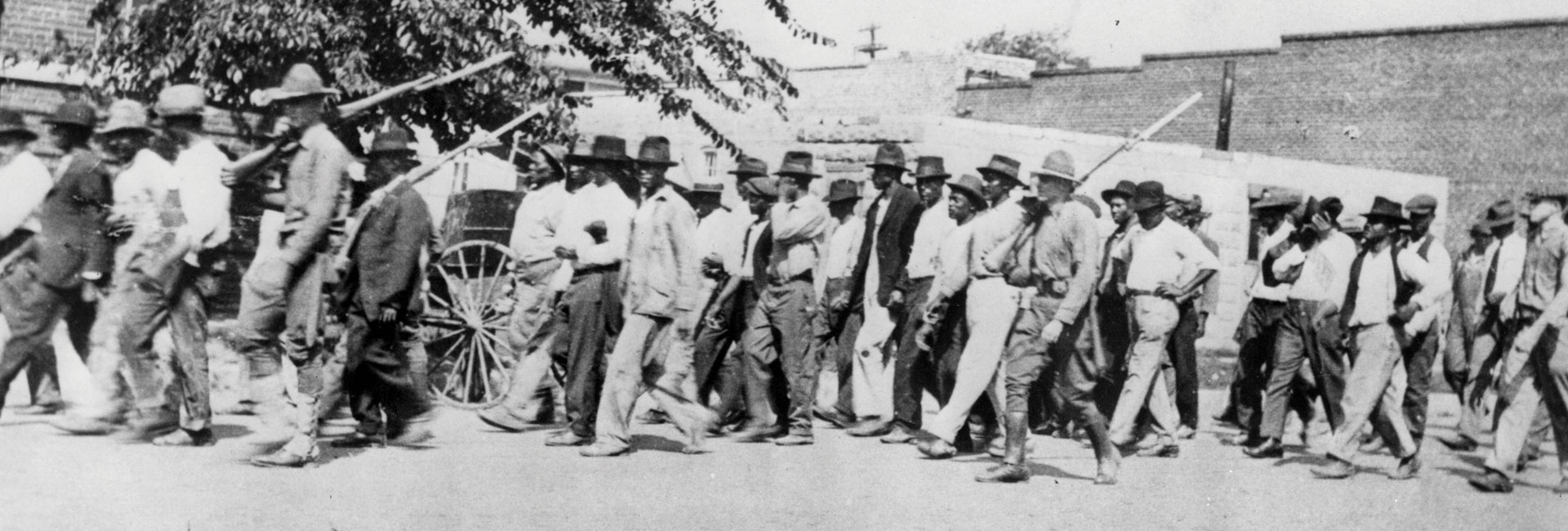
It’s no accident that Solomon-Simmons was kept in the dark. In the decades after the attack, Tulsa’s officials did everything they could to erase the memory of it and scatter Black Wall Street’s ashes to the wind. For decades, local newspapers and media were complicit, refusing to investigate or revisit the massacre.
But while the events of 1921 were a mystery to many, memories of the attack were seared into survivors’ minds and passed down to their relatives.
Seth Bryant, a corporate lawyer at the New York City law firm Bryant Rabbino, is among those who heard about the attack when he was a young child. He is the great-grandson of A.J. Smitherman, a civil rights attorney and newsman who published the Tulsa Star, a Greenwood-based newspaper.
Bryant’s grandmother Guelda was only a toddler when her older sister, Carol, swept her up into her arms and fled from the basement of their burning house.
As a kid growing up in the Cold Springs neighborhood of Buffalo, New York, Bryant remembers hearing bits and pieces about Smitherman, or “Big Daddy,” as the family calls him. But he could never be sure whether the stories he heard about him had taken on a life of their own. “Sometimes stories get bigger over time,” Bryant says.
It wasn’t until he visited Tulsa for the centennial of the massacre in 2021 and saw Smitherman memorialized that Bryant realized his great-grandfather was the hero he’d heard about back in Buffalo. “That stuff became true to me and a point of pride.”
In June 1921, a grand jury indicted Smitherman on rioting charges. He spent the rest of his life as a fugitive and never returned to Tulsa, Bryant says.
His great-grandfather fled to Massachusetts, from which prosecutors tried unsuccessfully to extradite him. He eventually settled in Buffalo so he could escape to Canada if authorities came looking for him again.
“He died a wanted man,” Bryant says.
"If we are to be a country that is about the rule of law, then there's just no way that you can ignore what happened in Tulsa without really understanding how it happened." –Seth Bryant
Smitherman died in 1961. And it wasn’t until 2007 that the indictment was dismissed after historian Barbara Seals Nevergold fought to show he shouldn’t have been charged.
Bryant first visited Greenwood in the late 1990s when he was still a young lawyer, jumping into the back seat of a cab and asking the driver to show him around.
When he saw that a highway had been built over this once-thriving Black community, it was like a punch to the gut. Only half a block of what was once Black Wall Street remained.
“You couldn’t even picture it,” Bryant says. “The gentleman wasn’t able to show me much, in part because there wasn’t much left that you could see.”
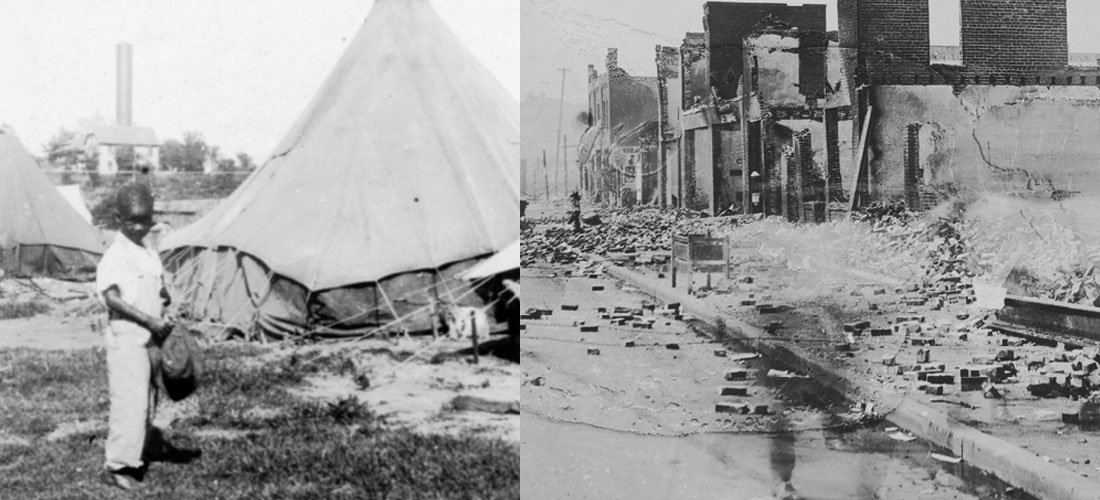
Greenwood enjoyed a renaissance in the 1930s and ‘40s. But systemic racism, redlining, “urban renewal” policies and a lack of restitution or reparations for the massacre ultimately left Black people in north Tulsa with “a lower quality of life and fewer opportunities,“according to The Case for Reparations in Tulsa, Oklahoma, a 2020 Human Rights Watch report.
The long-term impact plays on the mind of Nate Calloway, the great-grandson of J.B. Stradford, then one of the richest men in Greenwood, who lost his hotel, the Stradford, during the attack.
"He could have become the next J.W. Marriott. He could have held on to that compound wealth. But he was robbed of that. We were robbed of that." –Nate Calloway, great-grandson of hotelier J.B. Stradford.
Stradford was also a civil rights attorney who, like Smitherman, fought for Greenwood residents amid Jim Crow-era laws in a state where lynching was common.
Stradford was determined to defend his hotel, and even after rioters riddled it with machine gun fire, he stayed there throughout the night. Calloway says his great-grandfather left the hotel only after martial law was declared June 1, and National Guard troops arrived. They told Stradford they would guard it; instead, they stood by as rioters burned it to the ground.
“He could have become the next J.W. Marriott,” Calloway says. “He could have held on to that compound wealth. But he was robbed of that. We were robbed of that.”
Stradford was charged with inciting a riot. He became a fugitive and fled to Chicago, where he tried in vain to rebuild his empire. His name was finally cleared in 1996, six decades after his death. His son, C. Francis Stradford, went on to co-found the National Bar Association and the Cook County Bar Association.
Calloway felt a mix of emotions when he visited the Greenwood district for the first time in 2018. He was saddened. But as he imagined his great-grandfather standing on the stoop of his hotel and looking out over the neighborhood, he swelled with pride.
“It made it all very tangible. You hear about this stuff your whole life, but [when] you are standing where his hotel stood, it brings it full circle. It makes it that much more real,” Calloway says. “You think about what was lost and what could have been.”
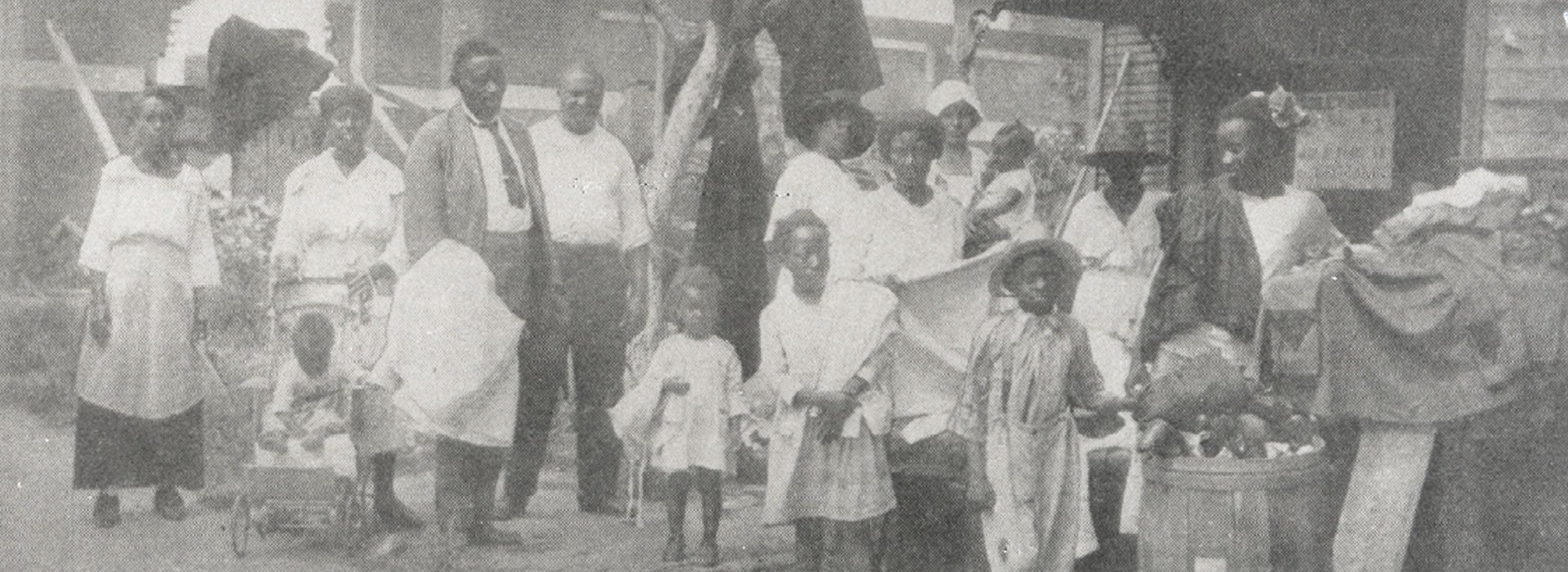
Bryant and Calloway say a victory in the lawsuit is important not just for the survivors and their descendants but also so the city and state are held accountable for what happened.
“The only way we’re going to live up to the ideals of our founding mothers and fathers is if we make amends,” Calloway says. “It might be a symbolic gesture, but symbolic gestures go a long way towards healing old wounds.”
Bryant says the lawsuit is the last shot at real justice for the survivors and other people impacted.
“If we are to be a country that is about the rule of law, then there’s just no way that you can ignore what happened in Tulsa without really understanding how it happened,” Bryant says. “You can’t allow people to try to cover up a crime by running out the clock and ensuring that justice will never be seen.”
After the attack, a grand jury report claimed the Black community was responsible. The only white person held accountable was Tulsa Police Chief John Gustafson, who was convicted on one count of dereliction of duty, fined and fired. No one in the mob was prosecuted for the killings, arson or looting.
According to the Tulsa Race Riot commission’s 2001 report, Black Tulsans filed at least 190 lawsuits after the attack to rebuild and redevelop the community and recover damages from insurance companies. But not one of the suits succeeded.
In 2018, Tulsa Mayor G.T. Bynum said the city would investigate potential mass graves in the Oaklawn Cemetery and other sites that could hold victims of the massacre.
In June, the city said it was working with forensic experts to complete a DNA analysis of remains found at Oaklawn in summer 2021.
"You can't allow people to try to cover up a crime by running out the clock and ensuring that justice will never be seen." –Seth Bryant
After Solomon-Simmons learned about the massacre as a university student, he made it his mission to get justice for Black Wall Street survivors.
He was 23 years old and a law clerk when he joined a legal team led by famed Harvard Law School professor and civil rights attorney Charles J. Ogletree Jr. and Johnnie L. Cochran Jr., who was best known for winning an acquittal for O.J. Simpson in his 1995 murder trial. The team filed a lawsuit for survivors in 2003. After losing in the trial and appeals courts, they took the case to the U.S. Supreme Court, which declined to hear an appeal in 2005.
Solomon-Simmons says he and other advocates sought reparations through proposed federal legislation called the Tulsa-Greenwood Race Riots Claims Accountability Act of 2007. The act was introduced in every Congress through 2013. But the lawyer says the legislation never got much further than one subcommittee hearing in April 2007.
Another bill introduced by Rep. Hank Johnson, D-Ga., in 2021 also has stalled, Solomon-Simmons says.
Determined to find a claim that could survive a dispositive motion, Solomon-Simmons spent 18 months with Miller and Tulsa attorney Spencer Bryan developing the public nuisance theory for the 2020 lawsuit.
Because the public nuisance statute in Oklahoma can bypass statutes of limitations, it seemed like the perfect vehicle for a new complaint.
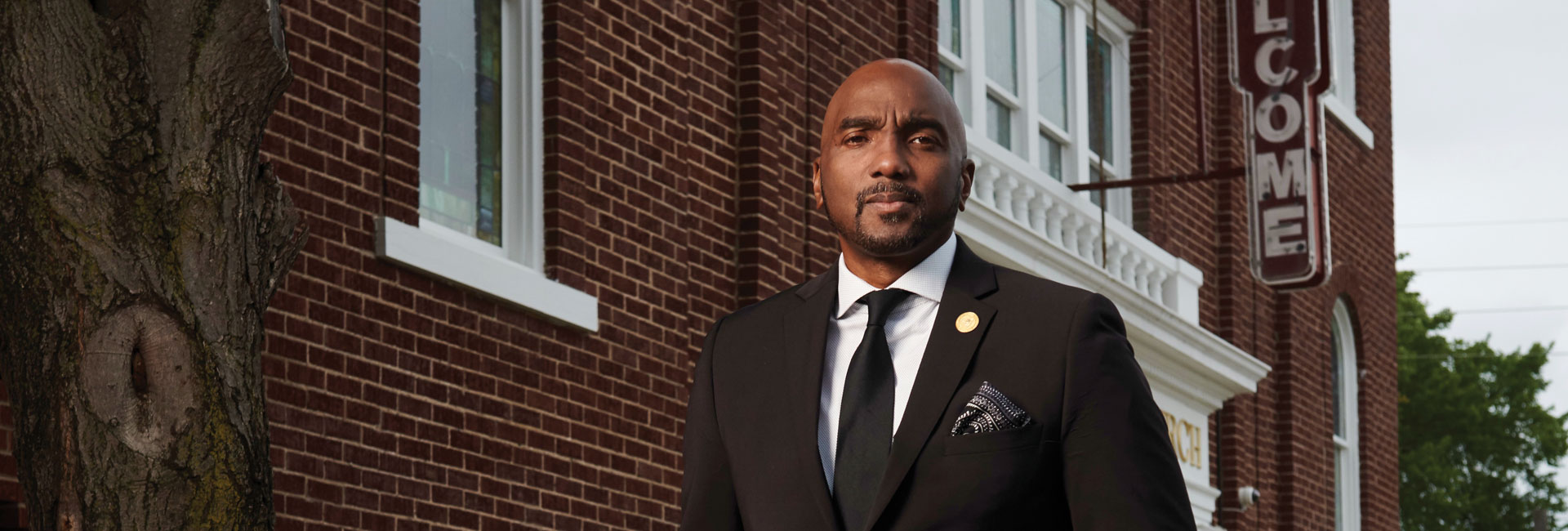
“I relive this every time I tell this story, but it’s like when you see a movie scientist. He’s done 300 experiments, and they all don’t work, and there’s that one time when he’s like, ‘This could work,’” Solomon-Simmons says of the process of coming up with the fresh legal angle. “That’s the type of moment we had.”
Under public nuisance law, a “triggering act” creates the nuisance, such as when oil spilled from the Deepwater Horizon rig in the Gulf of Mexico in 2010. The nuisance the spill created led to a slew of environmental litigation seeking to abate it, Solomon-Simmons says. As framed in his lawsuit, the triggering act that created the nuisance in north Tulsa was the massacre.
“That’s the equivalent of that oil spilling out into the ocean. They stopped the bombing, burning, looting, killing [and] destroying, [but] they’ve done nothing to repair the nuisance that was created,” the lawyer says.
Plaintiffs argued the nuisance was ongoing because north Tulsans still “face racially disparate treatment and city-created barriers to basic human needs, including jobs, financial security, education, housing, justice and health.”
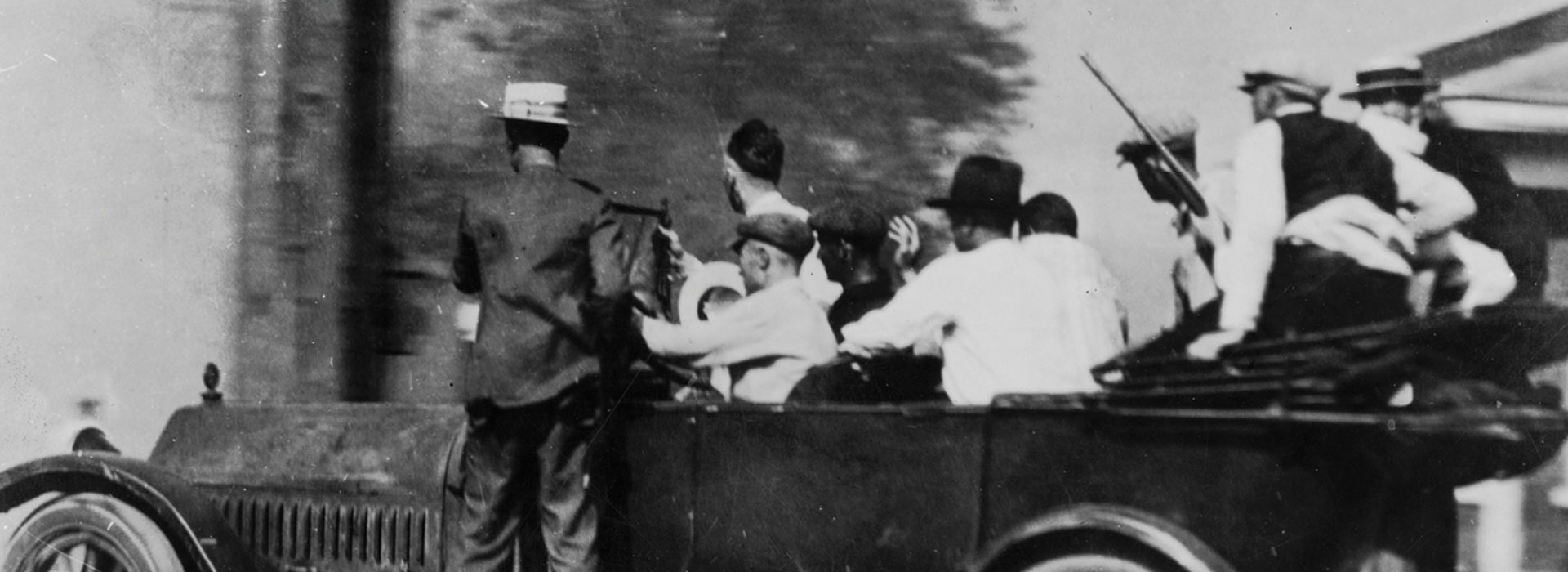
Among the defendants named in the lawsuit were the City of Tulsa, the Tulsa County Sheriff, the Oklahoma Military Department and the Tulsa Regional Chamber. Chamber attorney John Tucker declined to comment for this story, but Tucker has previously said the plaintiffs do not have legal standing to bring their claims.
In a March 7 brief, Tucker wrote that courts cannot address societal ills and the policy problems arising from the massacre. He argued that it’s up to government officials rather than the judiciary to solve those problems and decide whether to grant reparations. In her order, Wall agreed in part, rejecting the idea of an “ongoing” public nuisance, holding the claims “present political questions and therefore dismissal is proper.”
“This court declines to engage in management of public policy matters that should be dealt with by the legislative and executive branches,” Wall wrote.
Author and attorney Hannibal Johnson, who is one of the foremost experts on the massacre, says the very existence of the lawsuit should be celebrated for drawing attention to a once-forgotten part of history.
But he is also skeptical that the continuing problem of systemic racism fits into the framework typically used to support a nuisance claim.
“I see courts being wary of opening up a Pandora’s box whereby the judiciary would be asked to provide some sort of resolution for this historical racial trauma that spans the entirety of the United States,” Johnson says.
"I'm already fielding phone calls from communities around the country and lawyers who are looking at this." –Damario Solomon-Simmons
Still, Johnson points out that the lawsuit won’t be the end of the fight for justice. He notes his work on the Tulsa Race Massacre Centennial Commission, which he said pushed for schools to include the history of the attack in their curricula, and the building of the Greenwood Rising history center, where Johnson serves as curator.
“Should this lawsuit fail, it just forecloses one avenue,” Johnson says. “But there are many other avenues that we need to be pursuing anyway.”
And going forward, a public nuisance theory could prove a “powerful legal tool,” Miller says, offering a model for other civil rights attorneys who want to bring reparations claims barred by statues of limitations.
“I’m already fielding phone calls from communities around the country and lawyers who are looking at this,” Solomon-Simmons says.
But there is a long, heavy pause as he ponders the next stage of the case, knowing that time is of the essence.
Solomon-Simmons has persevered for this long, and so have the Tulsa massacre survivors. He notes that racism and white supremacy have prevented justice for 101 years, but he believes the wind is at their back to achieve some form of equity: “I don’t think we’re going to fail.”
